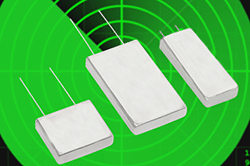source: prweb news
Cornell Dubilier Electronics, Inc. (CDE) has introduced the latest in its series of Flatpack ruggedized flat aluminum electrolytic capacitor, the MLSG. This series targets compact power supply applications in military and aerospace, as well as other critical systems.
New Bedford, MA (PRWEB)November 03, 2016
Cornell Dubilier Electronics, Inc. (CDE) has introduced the latest in its series of Flatpack ruggedized flat aluminum electrolytic capacitor, the MLSG. This series targets compact power supply applications in military and aerospace, as well as other critical systems. Design enhancements and a new electrolyte push the MLSG to nearly double the operating life of its predecessor, at no added cost. Two principal package profiles are offered in this technology, the MLSG Flatpack which measures just 0.5” thick and 1.75” wide and the MLSG Slimpack measuring 0.5” thick by 1.00” wide, both offered in length increments of, 1.5”, 2.0”, 2.5” or 3.0”.
MLSG Flatpack capacitors can be made to withstand up to 50g vibrations (10g standard) and altitudes greater than 80,000 feet. With stainless steel cases and near hermetic welded seals, they are built for extended duty in very harsh conditions. Especially noteworthy is that a high level of performance is maintained over the full operating temperature range. Capacitance retention at -55 °C is very strong, with excellent high temperature performance up to +125 °C. The new electrolyte system is fully REACH compliant, allowing application of the components in a broad range of applications where space efficiency and extraordinarily long life are required.
A wide range of standard capacitance values from 220 µF to 24,000 µF are available, with voltage ratings up to 250 Vdc. The unique flat package design does more than save space. It is easily cooled, and can offer unique flexibility in ganging two or more devices in ways that conventional electrolytics can’t.
Options include High Vibration (HV), for performance to 50g and High Reliability (HR), with burn-in at rated voltage and 85 °C. Where a true glass-to-metal hermetic seal is required, CDE offers the MLSH Slimpack, which is similarly constructed in a flat stainless steel package. It is available in nine values, from 120 µF to 3,200 µF, with ratings up to 250 Vdc.
“The latest MLSG Flatpack capacitors are purpose-built for their mission,” said Mike McGeachie, design and application engineer. “They provide a very high level of electrical and environmental performance. Engineers don’t usually have such an option when selecting passives.”































